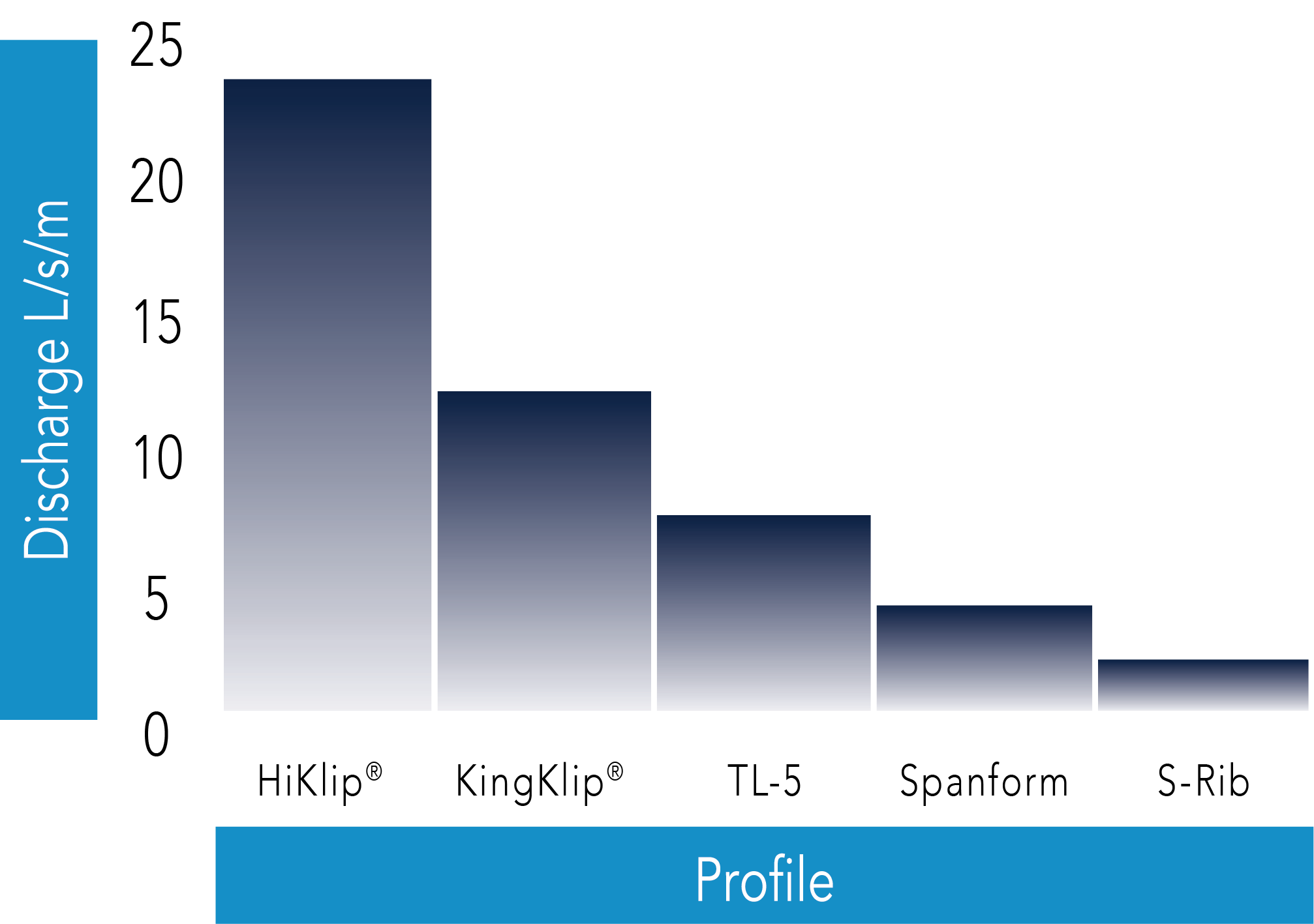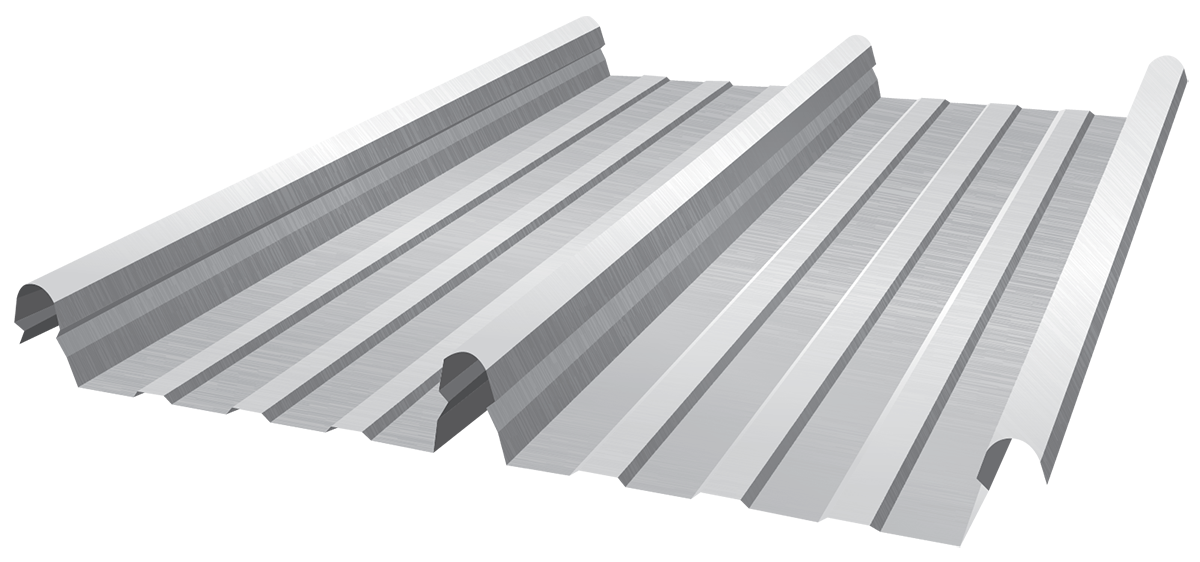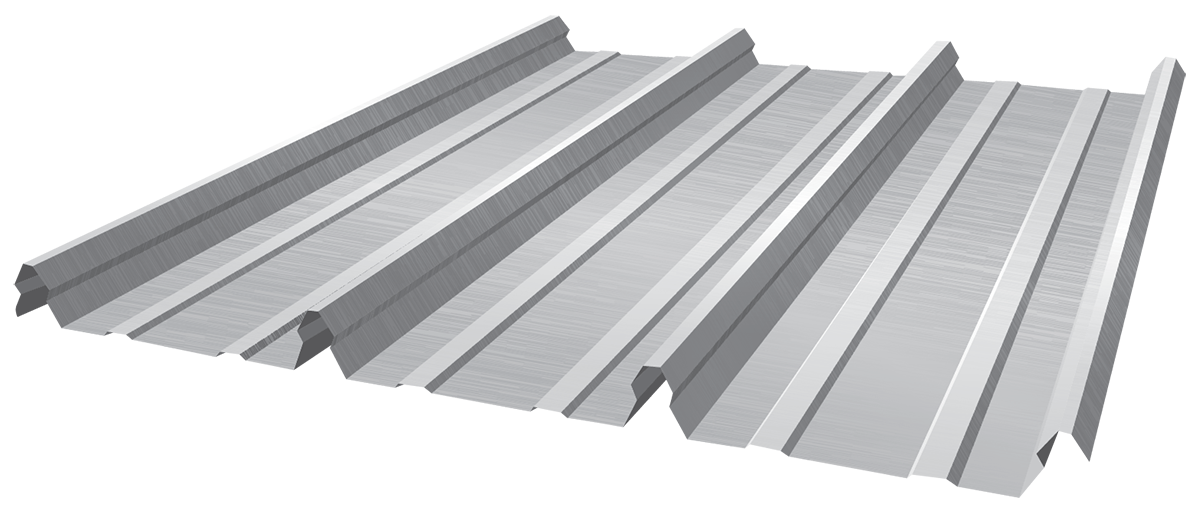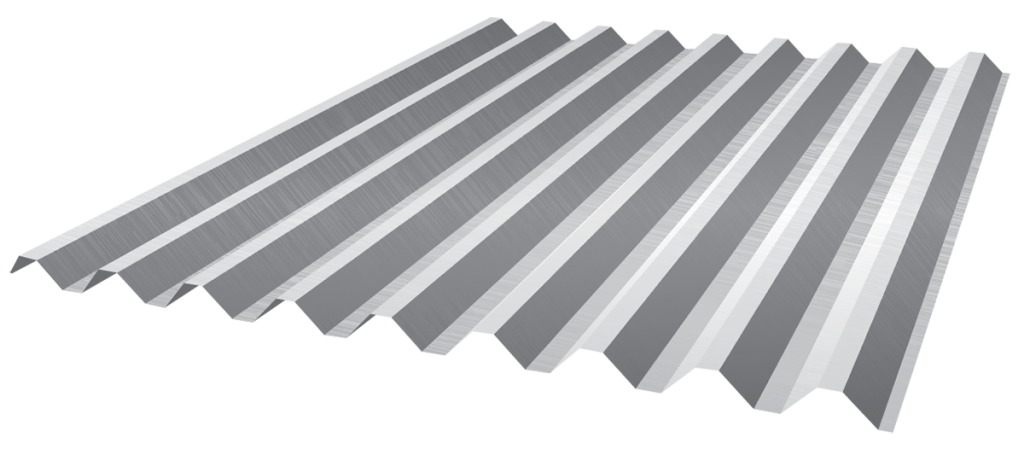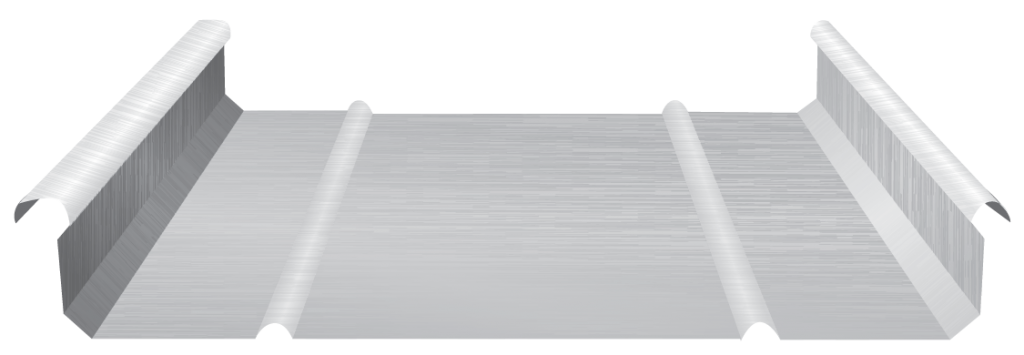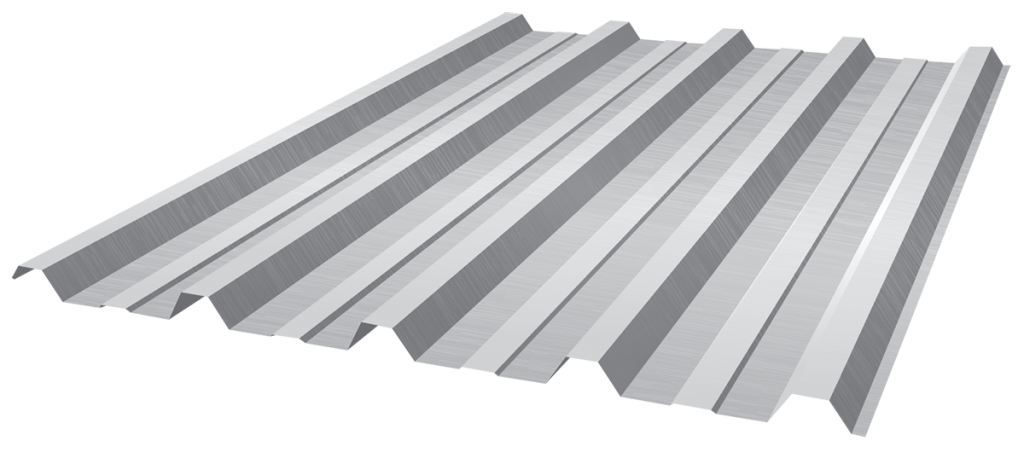Water Carrying Capacity and Rainwater Run-off
The Right Profile For the Right Job
In Australia, we experience vast differences in regional conditions as well as variations in the functional and performance requirements of buildings, yet most roofing manufacturers offer the same profiles for all applications.
Fielders® provide the largest range of long length concealed fix decking on the Australian market. Each profile has been developed to give maximum performance in a variety of applications, giving you the right roofing profile for any conditions.
Fielders® three concealed fix roofing profiles have all your requirements covered. KingKlip 700® is a premium wide deck with a clip design allowing faster installation. And finally, HiKlip® 630 has the greatest water carrying capacity on the market.
All concealed fix decks are backed by Fielders® unique 20 Year Watertight Installation Guarantee - and more importantly, they have no more holes!
Fielders® HiKlip® 630
HiKlip® 630 is the strongest concealed-fixed roofing product, and secondly, it has the greatest water carrying capacity of any deck on the market.
Fielders® recognised the demand for a concealed fix deck that provided total protection for buildings located in areas prone to flash deluges, high wind and rainfall. The result was that Fielders® designed HiKlip® 630. HiKlip® 630 is a revolutionary deep rib deck with two important performance features.
Both the HiKlip® 630 deck and clip mechanism exhibit great strength and are able to resist very high wind pressures whilst allowing the brackets and decking to slide independently of each other to accommodate temperature variations without unsightly step joints.
Rainfall Intensity by Locality (mm/hr)
| Locality | Average recurrence internal, once in: |
|
| 20 years * | 100 years ** |
|
| Adelaide | 123 | 186 |
| Arkaroola | 134 | 194 |
| Ceduna | 125 | 200 |
| Mt. Barker | 120 | 184 |
| Mt. Gambier | 108 | 168 |
| Murray Bridge | 117 | 181 |
| Nuriootpa | 111 | 164 |
| Port Augusta | 124 | 189 |
| Port Pirie | 125 | 201 |
| Yorketown | 118 | 197 |
*Minimum for eaves gutters.
**Minimum for internal box and valley gutters.
Notes:
Data for other locations may be obtained from local drainage authorities. Data for any locality in Australia (to a resolution of 1/40th of a degree of latitude or longitude) may be obtained from the Bureau of Meteorology.
Data shown for large cities are the maxima within the greater city area. Data for specific locations within these areas may be obtained from the Bureau of Meteorology.
More stringent requirements should be considered for buildings where the avoidance of gutter overflow is of paramount importance.
All gutters and outlets, particularly box gutters served by internal sumps, need to be regularly inspected and maintained to avoid breakages.
| Locality | Average recurrence internal, once in: |
|
| 20 years * | 100 years ** |
|
| Bacchus Marsh | 126 | 189 |
| Ballarat | 127 | 184 |
| Benalla | 133 | 187 |
| Geelong | 118 | 172 |
| Hamilton | 120 | 184 |
| Healesville | 129 | 192 |
| Horsham | 120 | 174 |
| Korumburra | 116 | 168 |
| Lakes Entrance | 124 | 179 |
| Melbourne | 127 | 186 |
| Mildura | 125 | 174 |
| Morwell | 129 | 196 |
| Orbost | 130 | 188 |
| Stawell | 127 | 185 |
| Wonthaggi | 114 | 165 |
*Minimum for eaves gutters.
**Minimum for internal box and valley gutters.
Notes:
Data for other locations may be obtained from local drainage authorities. Data for any locality in Australia (to a resolution of 1/40th of a degree of latitude or longitude) may be obtained from the Bureau of Meteorology.
Data shown for large cities are the maxima within the greater city area. Data for specific locations within these areas may be obtained from the Bureau of Meteorology.
More stringent requirements should be considered for buildings where the avoidance of gutter overflow is of paramount importance.
All gutters and outlets, particularly box gutters served by internal sumps, need to be regularly inspected and maintained to avoid breakages.
| Locality | Average recurrence internal, once in: |
|
| 20 years * | 100 years ** |
|
| Bridgewater | 101 | 156 |
| Burnie | 118 | 191 |
| Deloraine | 108 | 165 |
| Dover | 97 | 165 |
| Flinders Island | 128 | 184 |
| Hobart | 99 | 155 |
| Kingston | 98 | 154 |
| Launceston | 101 | 150 |
| Mt Wellington | 122 | 191 |
| New Norfolk | 100 | 166 |
| Queenstown | 118 | 183 |
| Scottsdale | 119 | 190 |
| Sorell | 101 | 152 |
| St. Helens | 131 | 185 |
| St. Marys | 205 | 266 |
*Minimum for eaves gutters.
**Minimum for internal box and valley gutters.
Notes:
Data for other locations may be obtained from local drainage authorities. Data for any locality in Australia (to a resolution of 1/40th of a degree of latitude or longitude) may be obtained from the Bureau of Meteorology.
Data shown for large cities are the maxima within the greater city area. Data for specific locations within these areas may be obtained from the Bureau of Meteorology.
More stringent requirements should be considered for buildings where the avoidance of gutter overflow is of paramount importance.
All gutters and outlets, particularly box gutters served by internal sumps, need to be regularly inspected and maintained to avoid breakages.
| Locality | Average recurrence internal, once in: |
|
| 20 years * | 100 years ** |
|
| Albury | 135 | 191 |
| Armidale | 154 | 219 |
| Batesmans Bay | 211 | 279 |
| Bathurst | 143 | 197 |
| Bowral | 170 | 225 |
| Broken Hill | 130 | 181 |
| Casino | 198 | 256 |
| Coffs Harbour | 232 | 293 |
| Cooma | 129 | 183 |
| Coonabarabran | 178 | 247 |
| Cowra | 144 | 203 |
| Dorrigo | 214 | 273 |
| Dubbo | 159 | 221 |
| Forbes | 151 | 209 |
| Glen Innes | 159 | 219 |
| Gosford | 189 | 240 |
| Goulburn | 145 | 197 |
| Inverell | 179 | 251 |
| Kempsey | 220 | 283 |
| Kiama | 224 | 283 |
| Lismore | 219 | 278 |
| Lithgow | 141 | 191 |
| Maitland | 169 | 224 |
| Merimbula | 207 | 278 |
| Mittagong | 172 | 277 |
| Mullumbimby | 250 | 315 |
| Murwillumbah | 244 | 302 |
| Muswellbrook | 141 | 195 |
| Newcastle | 181 | 233 |
| Nowra | 219 | 280 |
| Orange | 152 | 214 |
| Penrith | 166 | 220 |
| Port Macquarie | 223 | 290 |
| Robertson | 228 | 297 |
| Singleton | 148 | 199 |
| Sydney | 214 | 273 |
| Taree | 190 | 241 |
| Tweed Heads | 245 | 303 |
| Wollongong | 233 | 294 |
| Wyong | 186 | 240 |
*Minimum for eaves gutters.
**Minimum for internal box and valley gutters.
Notes:
Data for other locations may be obtained from local drainage authorities. Data for any locality in Australia (to a resolution of 1/40th of a degree of latitude or longitude) may be obtained from the Bureau of Meteorology.
Data shown for large cities are the maxima within the greater city area. Data for specific locations within these areas may be obtained from the Bureau of Meteorology.
More stringent requirements should be considered for buildings where the avoidance of gutter overflow is of paramount importance.
All gutters and outlets, particularly box gutters served by internal sumps, need to be regularly inspected and maintained to avoid breakages.
| Locality | Average recurrence internal, once in: |
|
| 20 years * | 100 years ** |
|
| Canberra | 137 | 194 |
*Minimum for eaves gutters.
**Minimum for internal box and valley gutters.
Notes:
Data for other locations may be obtained from local drainage authorities. Data for any locality in Australia (to a resolution of 1/40th of a degree of latitude or longitude) may be obtained from the Bureau of Meteorology.
Data shown for large cities are the maxima within the greater city area. Data for specific locations within these areas may be obtained from the Bureau of Meteorology.
More stringent requirements should be considered for buildings where the avoidance of gutter overflow is of paramount importance.
All gutters and outlets, particularly box gutters served by internal sumps, need to be regularly inspected and maintained to avoid breakages.
| Locality | Average recurrence internal, once in: |
|
| 20 years * | 100 years ** |
|
| Biloela | 220 | 298 |
| Brisbane | 251 | 333 |
| Bundaberg | 241 | 318 |
| Cairns | 282 | 368 |
| Cape York | 301 | 388 |
| Charleville | 170 | 236 |
| Charters Towers | 218 | 285 |
| Cloncurry | 172 | 228 |
| Emerald | 220 | 289 |
| Goondiwindi | 182 | 246 |
| Gympie | 228 | 299 |
| Hughenden | 199 | 266 |
| Innisfail | 254 | 323 |
| Kingaroy | 208 | 279 |
| Longreach | 189 | 251 |
| Mackay | 273 | 363 |
| Mareeba | 219 | 290 |
| Mt Isa | 169 | 223 |
| Mt Morgan | 225 | 300 |
| Noosa | 253 | 320 |
| Posperpine | 272 | 356 |
| Rockhampton | 248 | 336 |
| Roma | 192 | 358 |
| Southport | 246 | 308 |
| Toowoomba | 189 | 251 |
| Townsville | 260 | 346 |
| Warwick | 178 | 240 |
| Weipa | 293 | 370 |
*Minimum for eaves gutters.
**Minimum for internal box and valley gutters.
Notes:
Data for other locations may be obtained from local drainage authorities. Data for any locality in Australia (to a resolution of 1/40th of a degree of latitude or longitude) may be obtained from the Bureau of Meteorology.
Data shown for large cities are the maxima within the greater city area. Data for specific locations within these areas may be obtained from the Bureau of Meteorology.
More stringent requirements should be considered for buildings where the avoidance of gutter overflow is of paramount importance.
All gutters and outlets, particularly box gutters served by internal sumps, need to be regularly inspected and maintained to avoid breakages.
| Locality | Average recurrence internal, once in: |
|
| 20 years * | 100 years ** |
|
| Alice Springs | 139 | 204 |
| Darwin | 285 | 366 |
| Katherine | 230 | 304 |
*Minimum for eaves gutters.
**Minimum for internal box and valley gutters.
Notes:
Data for other locations may be obtained from local drainage authorities. Data for any locality in Australia (to a resolution of 1/40th of a degree of latitude or longitude) may be obtained from the Bureau of Meteorology.
Data shown for large cities are the maxima within the greater city area. Data for specific locations within these areas may be obtained from the Bureau of Meteorology.
More stringent requirements should be considered for buildings where the avoidance of gutter overflow is of paramount importance.
All gutters and outlets, particularly box gutters served by internal sumps, need to be regularly inspected and maintained to avoid breakages.
| Locality | Average recurrence internal, once in: |
|
| 20 years * | 100 years ** |
|
| Abydos | 199 | 275 |
| Albany | 142 | 217 |
| Broome | 252 | 343 |
| Bunbury | 148 | 215 |
| Carnarvon | 142 | 196 |
| Collie | 145 | 217 |
| Dampier | 231 | 337 |
| Derby | 254 | 343 |
| Geraldton | 132 | 173 |
| Halls Creek | 181 | 237 |
| Hamersley | 180 | 244 |
| Hillside | 192 | 265 |
| Kalgoorlie | 116 | 180 |
| Katanning | 125 | 203 |
| Kununurra | 256 | 347 |
| Marble Bar | 205 | 287 |
| Meekatharra | 111 | 155 |
| Mundaring | 139 | 204 |
| Newman | 143 | 195 |
| Perth | 146 | 214 |
| Port Hedland | 233 | 332 |
| Roy Hill | 160 | 216 |
| Tom Price | 164 | 222 |
| Wittenoom | 182 | 245 |
*Minimum for eaves gutters.
**Minimum for internal box and valley gutters.
Notes:
Data for other locations may be obtained from local drainage authorities. Data for any locality in Australia (to a resolution of 1/40th of a degree of latitude or longitude) may be obtained from the Bureau of Meteorology.
Data shown for large cities are the maxima within the greater city area. Data for specific locations within these areas may be obtained from the Bureau of Meteorology.
More stringent requirements should be considered for buildings where the avoidance of gutter overflow is of paramount importance.
All gutters and outlets, particularly box gutters served by internal sumps, need to be regularly inspected and maintained to avoid breakages.
The data relates to a storm of five minutes duration and an average recurrence interval of one in 20 years for eaves gutters and one in 100 years for valley and internal box gutters, based on Australian Rainfall and Runoff (1987) published by Engineers Australia.
